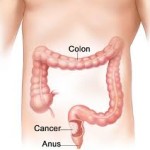 Colon cancer is a cancer of the large intestines. This is the lower part of the digestive system that is responsible for gathering waste products and eliminating them from the body. Often the terminology, colorectal cancer, is used to describe the cancers which occur in the lower intestines. Rectal cancer will happen in the last 6 inches of the colon.
Colon cancer is a cancer of the large intestines. This is the lower part of the digestive system that is responsible for gathering waste products and eliminating them from the body. Often the terminology, colorectal cancer, is used to describe the cancers which occur in the lower intestines. Rectal cancer will happen in the last 6 inches of the colon.
Approximately 112,000 people are diagnosed with colon cancer annually. Even though this particular cancer is very preventable it also ranks as having the second largest number of deaths due to cancer. Most cases start as a small benign clump of cells called a polyp. Over time these polyps will develop into cancer. Polyps can be small and will produce very few symptoms, if any at all.
In order to effect early diagnosis and effective treatments regular screening tests are needed to identify the polyps before they become cancerous. When signs and symptoms do appear it often means that a cancer has developed.
Cancer of the colorectal area can cause a variety of symptoms, not all of which mean colon cancer. A number of other medical problems can also cause similar symptoms. The first of which is a curable bowel syndrome which is a common digestive problem that causes stomach pain, cramping and bloating as well as diarrhea and constipation. Diverticulitis is  another condition, in which pouches form on the walls of the colon and can cause similar symptoms. Infections that cause diarrhea of such as salmonella and inflammatory bowel diseases, which can cause swelling and sores in the intestines will also develop from symptoms similar to those of colon cancer.
another condition, in which pouches form on the walls of the colon and can cause similar symptoms. Infections that cause diarrhea of such as salmonella and inflammatory bowel diseases, which can cause swelling and sores in the intestines will also develop from symptoms similar to those of colon cancer.
In the early stages, colorectal cancer doesn’t usually cause any symptoms. When symptoms do occur, the cancer may be more difficult to treat. Some of the more common symptoms include pain in the abdomen which can vary depending upon the area of the tumor. Individuals who have colon cancer will also experience blood in the stool or very dark stools. The color of the stool is a result of metabolized blood which made its way into the intestines. When the blood is visually evident in the stool, the tumor is often located lower in the intestines, and when the stool is darker the tumor may be located higher up.
Individuals will also experience a change in bowel habits, such as more frequent stools where feeling that the bowels are not completely empty. Because of the probable anemia, individuals will also suffer from fatigue.
In rare cases the tumor will interrupt the absorption of nutrients into the body and results in unexplained weight loss. Individuals may also suffer from diarrhea or constipation depending upon the location of the tumor and how much of the intestines it is blocking. At times the stools themselves are more narrow which indicates the tumor is lower in the rectum. Individuals can also suffer from bloating, fullness, cramps and vomiting.
At times individuals will find they suffer from nonspecific symptoms which include fatigue, weakness, shortness of breath and cramping.
Colon cancer can be present for several years before individual develops symptoms. It is for this reason that annual screenings are very important to prevent the development of advanced stage colon cancer which is significantly more difficult to treat. Through early detection, diagnosis and treatment, individuals are often able to experience a very effective treatment protocol which doesn’t affect their lifespan.



Leave a Reply